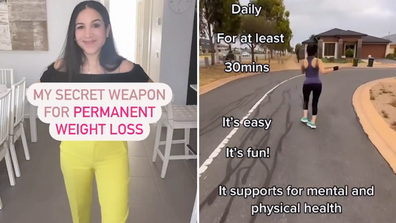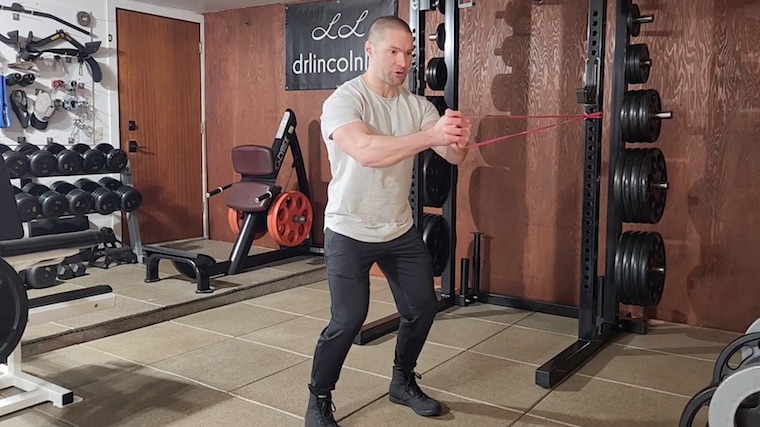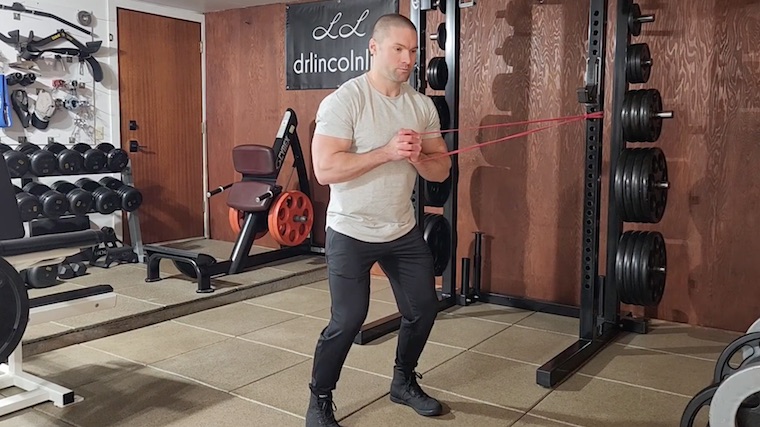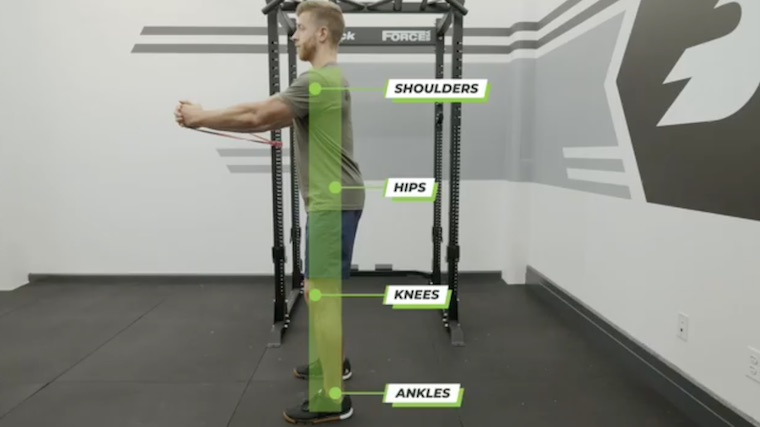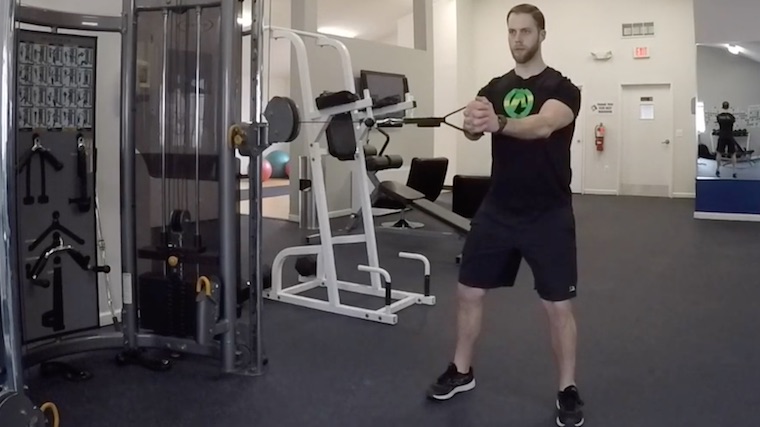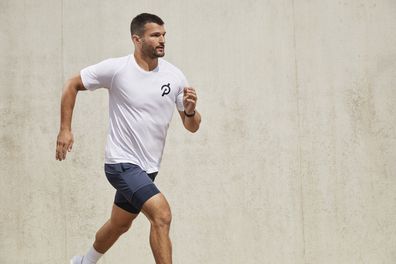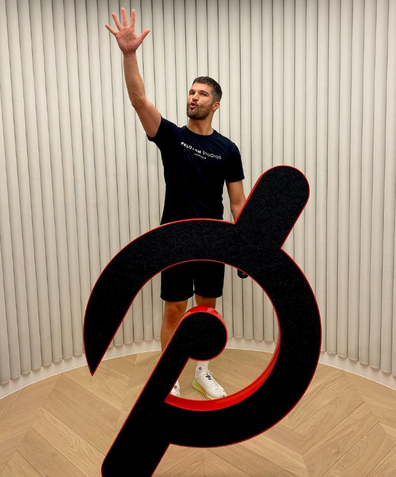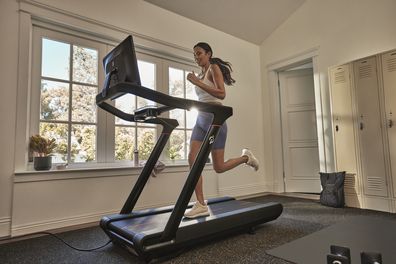Men’s Journal’s Everyday Warrior With Mike Sarraille is a podcast that inspires individuals to live more fulfilling lives by having conversations with disrupters and high performers from all walks of life. In this week’s episode, we spoke to Matt Higgins, entrepreneur, investor, and business leader who’s made a name for himself in the world of startups. He’s the vice chairman of the Miami Dolphins and was a guest ‘shark’ on ABC’s reality television series Shark Tank from seasons 10-11. Higgins shares his insights and experiences on what it takes to succeed, whether you’re an aspiring entrepreneur or simply curious.
Listen to the full episode above (scroll down for the transcript) and see more from this series below.
This interview has not been edited for length or clarity.
Michael Sarraille 00:11
All right. Welcome back to the Men’s Journal everyday warrior podcast. I’ve got Matt Higgins today, you guys probably most famously known from Shark Tank.
Michael Sarraille 00:20
We just had about a 30 minute conversation, some off the record. So we basically had a podcast before the podcast a matt, welcome. And thank you for joining us.
Matt Higgins 00:29
Thanks for having me. Don’t worry, we saved some good stuff for this guy we
Michael Sarraille 00:32
didn’t, we’ve actually found some good things to bring up. So Matt, I gotta ask you up front. What do you think your hit record is, in terms of companies being put in front of you, of whether you think they’re going to succeed or not?
Matt Higgins 00:44
I think my hit record, you mean, how many actually will succeed? Or how right?
Michael Sarraille 00:48
The ones you choose the ones you say, yep, that one’s going to be successful. And then the ones you pass on that go on to be highly successful? What do you think your hit hit rate is?
Matt Higgins 00:56
So funny, I actually think it’s not so much my hit rate. It’s whether or not I had the courage to actually act on what I know was true, or whether I listened to some of the voice in my head or judgment. So I don’t know, man. I’m gonna say probably 20%. In terms of acting on it.
Michael Sarraille 01:11
You know, you really let me ask you this, because I know everyone within your space has a story of God dammit. Had I only invested in that company? Just something that just didn’t smell right. Or maybe it wasn’t my passion? It didn’t feel right. What’s What was that a unicorn that you just passed up on that year? Okay.
Matt Higgins 01:27
So that’s a great story talking about my book, Berta votes, Airbnb. So Brian Chesky, the CEO of Airbnb, everything about that company told me that that he was going to do what he ended up doing, right. But there was a moment in time when the company was trying to break through all the regulations in different cities, right. And we met with him in my office with my partner, Steve Ross is one of the largest developers in the country, if not the largest, right. And he had Brian in the room, and rightfully so was sort of talking about why it was bad for New York and you know, given him the speech from a developer’s perspective, and I remember thinking like, while that may be true, from a vertical, the business, you know what I mean, but, you know, holistically, I don’t think it’s gonna matter, right? Like, he’s going to figure it out, he’s going to get the regulations change, he’s going to build a massive business. And we ended up passing. And I remember thinking, like, we’re passing for the wrong reason, like, it doesn’t matter how we feel. And that’s, I think, a big mistake investors will make, it’s like, you tend to sort of bring your myopic focus to make a judgment instead of disassociating. And you’re saying, well, it may not work for you, but it’s going to work for most and it’s gonna be a big business. So we stupidly passed on Airbnb, I put it in the book to hold myself accountable. It’s funny that you bring this up. It’s one of my most, I could have retired, I wouldn’t be talking to you right now. If I just didn’t check. I’d be in the Cayman Islands, you know,
Michael Sarraille 02:40
you wouldn’t retire. You know, that is the biggest fucking fallacy is like if I if I had $20 million, I would.
Matt Higgins 02:49
Now I feel completely unsuccessful. So it really doesn’t matter how much is in the bank.
Michael Sarraille 02:52
You so a buddy of mine, who actually he owns a company called Icahn. And I think they got the contract with this guy is just the nicest guy, just a disrupter, an innovator, he created a company called iKON. And they basically, what’s the word? It’s almost 3d print houses. He got the contract for the lunar base with with NASA. But of course, he’s in a circle of guys that are all multimillionaires to the tune of 60 million, if not up to up to 500,001 of his buddies had a vodka. I won’t say the company, but they got bought out. And he basically made 100 million. And my buddies asked him, he’s like, What are you going to do now? You could do whatever you want in life. And just in blacks. He said, Well, I want what my other buddy has, because he has 200 million. Hmm. And I find that very interesting. And I don’t think it’s greed.
Matt Higgins 03:41
That he admitted, by the way, I mean, I kudos to him for making something so gluttonous, but
Michael Sarraille 03:47
I don’t think gluttonous or is it’s like, that’s just the next challenge. I don’t know what it takes. Well,
Matt Higgins 03:53
I only say gluttonous. Well. And I guess I’m making a judgement because it’s not how I’m wired, wired. I’m wired for the pursuit. Right. The whole purpose of my book is that I do think that human beings, they think that we’re pursuing winning or what the joy of living is truly in the striving. So I’m in it for the perpetual pain and discomfort, I’m not in it for the byproduct, which is the money but that’s easy to say when you already have a good amount of it. I’m also not in it to compete with anybody else. I think that’s pathetic. I don’t compete with anybody but Matt Higgins. So you know, like, I don’t let that creep in my head about what somebody has or not. Because you know what I love accumulating you could appreciate this given you’ve done something that so few people in the country have ever done or could have done, right? I like accumulating things that money can’t buy you money can’t buy you a spot on Shark Tank and money can’t buy you a spot on faculty of Harvard. So I don’t care how much money somebody has go do those hard things.
Michael Sarraille 04:42
Yeah, didn’t know you’re right. You know, what I found along the way is like the destination. You think it’s going to provide all this joy and it doesn’t. It’s not the joy that you think it’s going to provide? You know, I told you earlier about this triple seven that we just did. Again, everyone in We’re all set. We couldn’t do it, it can’t be done. We did it but but within I think 10 minutes of, of doing it, we just sort of shrugged our shoulders and went back to enjoying the the camaraderie of the guys around us and like, we’re waiting for the the world record certificates to to arrive and I know what I’m gonna do with that world record certificate and I’m gonna post it on social media. It there meaningly meaningless to, we’re already talking about, hey, what’s the next fucking challenge? Right? The next thing?
Matt Higgins 05:32
Right? I think the sooner you accept that in life, especially young people, that happy early I write that in the book about the melancholy that marathon winners experience that Olympians experience. And the reason is, is because it’s not what anybody has been the top of the mountain realizes there’s not much to see. It’s thinking you like looking up, not looking down. And so I fortunately accepted that really early. A little bit. Like, you know, when, when Eliza says to Hamilton, why don’t you right, like you’re running out of time, like I just realized, you know, I’m on the clock, and I’m just gonna keep accumulating difficult experiences, but it really is so meaningless. Like I just doesn’t doesn’t it doesn’t satisfy anything, which is sort of sad, but also, okay.
Michael Sarraille 06:08
Yeah, you know, that that that is definitely if we had a psychologist here, he described it at some personality flaw. I wonder what?
Matt Higgins 06:15
It’s funny you say that because I think you’re perfectly fine. And you think I’m probably perfectly fine. So screw the psychologist. But what does psychologist say that that’s wrong? As a Buddhist would probably say it’s not so I don’t know. Maybe they would maybe the word justice.
Michael Sarraille 06:27
Let’s go here. Have you ever heard you know, I’m in the pursuit of balance? I’m sure nobody. Nobody says I want to be completely fucking unbalanced. It’s That’s That’s ludicrous. Yeah. What are we unregulated? Yeah. But, you know, I had Terrell Owens on and I said, Well, how did you achieve balance? And he’s like, it was almost like the Allen Iverson moment. He’s like, practice, practice. Are we talking about practice? He’s like, balance, about what he’s like, What are you talking about? When it comes to highperformance? There is no balance. So I’ve started to shift. My, my, my, my view of like, there’s beauty and disharmony. And you just have to find how all the things in your life business family, how they just sort of linked together even though there’s a disharmony when you’re trying to achieve a call what you’re trying to achieve greatness in your eyes. Yeah. Thoughts on that man?
Matt Higgins 07:19
Well, no, I 100% agree. I mean, look, I like the word extraordinary, because we break it down. It’s extra or write extraordinary things require extraordinary efforts. So I’m actually never in pursuit of balance. I also resist habituation, except to the extent it makes life more efficient. Very few areas of my life are actually habituated because my mind needs time to roam because I’m doing impossibly hard things. I wrote this book, I’m working on making it a bestseller and my own TV show, I do very disparate hard things and unconnected industries. And so my mind needs to be as creative as possible. So very few things are happening. I know that’s contradictory to what a lot of the advice people get, but I need a degree of chaos to be successful. So I’m not in pursuit of balance. I’m in pursuit of intermissions. Little, little little breaks, and then I returned to chaos.
Michael Sarraille 08:05
I just had Stephen Fogg, who’s a famous McKinsey executive performance coach, he just wrote a book called intrinsic motivation. Learn how to love your work. And he did. He actually said that he said, You know, there’s been this overemphasis on the power of habits, which he’s saying is not a bad thing, like small things, like getting up at 5am and maybe getting your workout in are great. Yeah. But he said, when he said, if you continually do things the same way through the same lens, you start to actually find this satisfaction, and it kills innovation and disruption. So I love that you say that?
Matt Higgins 08:36
Well, you just gave the GM one good one. So I’ve been trying to audit myself because I do feel I’m teetering on chaos. You know, when I do something really hard that requires, like, I get up every day at 4am. And I work on this book till midnight, right? And so I’m on I’m on the brink of death at the moment, as we talk, this might be my last interview. So I’m trying to restore a tad bit of balance. So the one you just mentioned that the one that is absolutely irrefutable. I refuse to allow myself now to turn my phone on until I get to the gym, and I just hit it. And then now the whole time, like I kind of turn the phone. So that’s using the power of habit to you know, to make me do something, but other than that, I don’t do many things.
Michael Sarraille 09:12
Lose your measuring stick for whether you’re maybe, you know, the wheels are about to fall off. Is it you is it family members? Or are you pretty in tune with where you’re at mentally?
Matt Higgins 09:22
I mean, I made the single greatest decision on my life. I had gotten divorced, degree personally decimated on many levels, right. I had to rebuild my self esteem. But I ended up meeting my wife, online, actually. And she’s the greatest force multiplier I’ve ever encountered, and truly the most regulated talented human being. So people like who’s your mentor? I’m like, That’s my wife. What do you admire the most is her so she but she is willing to go the distance to she comes up against the edge of total chaos and can handle it. So if she’s sounding the alarm, I know we’re totally we’re definitely screwed. So it’s like the But you know, her sleep cycles is a gets becomes dysregulated like mine, like I started seeing her take on water and then and then that’s it. And other than that I don’t I don’t listen to anybody else because unless they’re doing and they know what it looks like to do it it’s like you can’t possibly tell me like unless you’re working on writing a book at the same time as teaching at Harvard, you know? So yeah, that’s the honest answer. It’s just her myself.
Michael Sarraille 10:22
That’s, that’s, that’s pretty accurate. I’d be lying to you. If I didn’t tell you my wife was in tears and yelling this morning about the pace, what do you do? Go on, I want to hear it. It’s just, we just got back from this triple seven, I took off the next week. It’s just my body’s not recuperating very well. And she’s like, you just can’t do this. And I’m like, Oh, I know, I can’t do this. But I will do this.
Matt Higgins 10:49
And then I’ll I’ll provoke I’m like, what do you do you think I’m crazy? Do you think this is crazy? And she’s like, Nope, didn’t say that. If you’re good with it, just saying start a look.
Matt Higgins 10:58
Let’s be honest, you know, everyone acts a little differently when you’re courting someone. That’s fair. And then the cool guy. Yeah. And then things start to you know, be exposed as you date. And then, you know, after you put a ring on it for engagement, you show a little more. And then I think after marriage, there’s you know, the honeymoon phase, but where’s often you completely show you’re full of herself? Well, this is why I 100% agree with you a caveat. This is why I’m convinced that my wife is a Russian spy, because she has perfected that she was the cool girl during courtship and remain so as the wife and I’m like, either this is a very complicated Rico investigation. You’re undercover like FBI, or you’re a Russian spy, because she’s mad at we’re 10 years in, I’m like, when are you going to grow tired of me this is like, this is crazy. But like film on the week, we’re gonna drive right off the cliff, you know, if somebody doesn’t rein it in, but, you know, fortunately, and this, I love that we’re talking about this, because we don’t talk about enough in business. If you no country, no person has ever won a two front war, if you have somebody in your foxhole is not on your team, you will fail, you know, no matter what.
Matt Higgins 12:05
I know, I know. So I’m sorry.
Michael Sarraille 12:10
The parallels between business and in war or military, RC are so closely aligned, it’s not even funny. In one of the things you had a great professor, this guy is, he’s a longtime professor at the University of Texas. He was a Vietnam pilot in actually shutdown twice in one day, which Who the hell gets if I get shot down and I live, I’m probably going to take the day off. He got back in a helicopter, you know, you know. And he talks about how the modern style of business management was derived from the military, especially in post World War Two where almost everyone served, but I know you’re referring to Napoleon, and Hitler amongst a lot of others lost on two fronts, but the good old USA Today we did it once we did it once we did it well, and we probably would never succeeded it again. But I’m so glad you’re honest about meeting your wife online. You know, a lot of people have comments on that I met my wife online. You know, what I love about these apps, is it there’s there’s there’s an efficiency and effectiveness to it. Especially for guys that have very little time. And you’re getting access to people in this this. This is men or women that you wouldn’t traditionally run into at a bar. And I think that’s freaking awesome.
Matt Higgins 13:22
I love this topic, because I actually have a profile somewhere because I was just talking about this the other day, what’s great about going online is you get to sift through reams of data. And you’re using the right head, you know what I mean? I’m making that decision. And so you’re using your mind and saying, like, what do you what do you think intellectually, right? Like, what is this person right? For me, my I always joke with my wife, like, you put together the perfect composite sketch of the of a cool girl. And I remember we first have on our first date, I said, Okay, if this profile is not aspirational, and that’s actually true, I was like, we’re gonna have a really good life. And we never had a bad day since and whereas if I had met somebody in a bar, you’re responding to, you know, chemicals, or like, or the alcohol or I think online is amazing, you know, maybe you know, stereotyping, but women I think, tend to be a little more transparent than men are. So maybe it’s easier for a guy to find a partner online, but I’m so glad I found her online.
Michael Sarraille 14:11
I just go by, you know, sort of just swipe, swipe left, I just swiped letters, is it right? Which one was I swiped right on everything. And it was process of elimination from there, whoever, whoever responded back, I’m kidding. But I do. Take what you get, you know, Hey, what did Gretzky said you miss 100% of the shots you never take so I just take 100% Let’s talk about your book because I love this burn the boats is such a great quote that we in the military know so well. I know it’s been a credited to Cortez where he had 600 Basically, I think soldiers 100 sailors
Matt Higgins 14:52
and basically told them to burn the what was it six or 16 ships? Yeah. All right, to make sure that they were one of the things that At least Yeah 15 Yeah. Well, you know, this court well, so forgive me for telling the audience in you master of the obvious stuff, but I’ve actually what I was fascinated, we noticed Cortes and Cortez was kind of a bad guy, right? So it’s been vilified So, but I’m actually not using it in that context. What I found fascinating is if you go back to the beginning of recorded history, including the Old Testament with the ancient Israel, yes, you go back to the Chinese and fight. And 207 BCE, they had a general their same exact story. Every culture and every century on earth has the same hero’s journey where when a military strategist has the backup against the wall is outnumbered. They do two things, they eliminate their retreat, and they eliminate their food supply. So they have no other choice. And so I thought, well, that’s interesting. I saw Rex Ryan give a speech in 2011. When I was running the business of the Jets, we work together. And he was in the room with the players. We were facing the Steelers, we were an underdog. And he gives us he’s a big bear of a guy whose jowls are animating, he gives a speech about cord ties. He burned the boats, these are all like young kids. So they had no idea. But the next day they want they want obviously the next day, the times does an article and they asked a bunch of guys, you know, why do you think you want to go? Honestly, we heard about this Cortes guy burning the boats. We just we just achieved another level. And it stuck with me that these young kids were crediting this notion. So I want to write a book that was devoted to why do we reject this idea that to be truly successful? You have to sort of be all in because this this title deliberately provokes a good percentage of people who say, Matt, you’re being irresponsible, I gotta pay the rent, I gotta pay the bills. If you read my book, that’s actually not what I argue. I am one of the most anxious, nervous not, I’m one of the most, you know, you understand what I’m saying? Right? Yeah, I have anxiety too. But I process risk at the beginning of my journey so that when I’m going all in, I can remember Hey, Matt, you already thought about what’s the worst could happen. Get that out of your head, and you got to focus on being successful. So I wanted to write a book that wasn’t as simplistic as like, burn the damn boats. It was what does it take to burn the metaphorical boats in your life that holds you back internal and external, so you can commit to your potential?
Michael Sarraille 17:04
Yeah, you just said something. Your anxiety, I think, you know, my wife is getting annoyed of the fact I come home. And I’m like, we’ve got to tighten down the buckles.
Matt Higgins 17:16
We do the craziest thing. So we just got rid of an apartment like pave, the world is coming to an end. I’m positive this time. We put she’s like, I think you’re doing okay. I’m like, Ah, but it can be gone tomorrow. We got to sell
Michael Sarraille 17:26
everything. When she gets annoyed because the next day come home. And I’m like, we’re gonna do so well. She’s like, What is it pick a lane? Because I’m getting tired of this. Yo, yo. No, no, but it is interesting.
Matt Higgins 17:37
I love that. You just said that, by the way. Because I you know, we can be so macho and just project that like, this is all about confidence. No, we’re fallible human beings, we have anxiety, we’re taking risk, it’s scary. It’s about handling that risk and handling that anxiety, managing it,
Michael Sarraille 17:49
you know, some people view calling other people out as unprofessional. And I can see that that argument. I’m not calling anyone out here. What I’m saying is, I’ve seen some people that and you know, with social media, everyone has a microphone these days, whether they have credibility or not. I do look at credibility. Why would I listen to this person? Oh, Matt clearly had a very, you know, poverty stricken childhood working, say himself out of, you know, one didn’t graduate, got his GED, worked his way out, will take care of his mother, it’s been so successful. I’m going to listen to this guy, because this guy definitely has some breadcrumbs, that he can lead for me or leave behind to success. But there are some people that put up just this, like, this bad guidance of, you know, all in all the time 110% grind into these almost these platitudes, which I think are great and have have merit, but very few leaders like yourself, actually show the soft side. And you just talked about anxiety, people wouldn’t guess that the soft side of y’all. And I don’t see the flaws. But yeah, hey, I do. I do worry constantly all the time as well. People don’t hear enough of that. That vulnerability, I think is the best way to describe it.
Matt Higgins 19:07
I love that you’re saying that because it’s one of my biggest fears to be a little more explicit. I can’t stand the Instagram heroes narrative, where it’s like you everyone manufacturers, or they had some type of vulnerability or trouble, but they rose like a phoenix. And now I’m going to tell you how I did it. It’s like, Wait a second. I’m regressing every single day. I wrote a book I asked her if the shit out of my own book, because it’s aspirational. I can barely follow half my advice. I wrote a book so I could read it. What’s the matter with you? Like, why are you so you know, like, I’m being honest about it. And I talked about how I went on Shark Tank. And I talked about how I had impostor syndrome. And people somebody said to me the other day, they’re like, why would you be that that would have been the easiest thing I ever did. I was like, Well, you never you never did it, number one. Number two. It’s because I came from dirt. And I thought people could see through me, and I’m sharing it because when you watch the tape of me on Shark Tank, you’re like that kid’s a natural. It’s like, well, that’s not making a gift of myself. It’s not useful. So I want to be useful to let you know, actually, I was freaking out. Because of course, I’m freaking out I was a high school dropout with Mark Cuban. Now I performed and that’s what winners, you know do but with this book, it’s a little bit of retort to the nonsense sunny Instagram posts that are not even actionable to be like, what is failure really look like? What does anxiety look like? Let me also share with you a detail that I want to share about my divorce and how it leveled my self esteem. Let me talk about my testicle getting cut off and what that did to be my sense of being a man. Like, you know what, I find guys when they are people, women that when they achieve this level, they want to package it. Okay, I’m done now. And I’m like, no, no, I’m not even I have regrets all the time.
Michael Sarraille 20:36
Yeah, yeah. Yeah, it’s funny you say imposter syndrome. And the amount of self doubt that I have, I think, what one attempts down on my ego, and we all have egos to some degree. But impostor syndrome, because I served and I know, you know, one of I would consider a mentor in many ways. I didn’t serve directly for him. But you know, you mentioned a seal in the book named Kirk, can we say his name?
Matt Higgins 21:01
Yeah. Kurt did say loud. Or Cronin
Michael Sarraille 21:05
who Cronin had these peers to you. And I’ll say their names one Chris Castle Fussel because he wrote the book. He’s the president of McChrystal group, General Stanley McChrystal is Consulting Group. I mean, these guys were all cut from the same cloth, talk about an amazing group of mentors I served with, you know, I am who I am because of the men and women I served with and how much they poured into me. But Kurt, embodies what you’re talking about, you know, he, you know, people met Kurt, when they would never think he was a Navy SEAL. They’re like, Wait, this guy killed people for a living. Just his empathy, his respect, his kindness, his humility are off the charts. You live in a different world than I am. And you’ve got some people that have built with, let’s be honest, fucking money, amazing wealth. Do they still have that that some that semblance of, you know, kindness, respect, empathy, and humility that I’m talking about?
Matt Higgins 22:00
Not some do. Not like that I tell you the best do? Not entirely. To be honest, it depends on I find the best leaders do operational leaders. But a lot of people with fantastic wealth of breakout success don’t really have to be operators. Frankly, one thing I do talk about in my book, which is interesting, I believe that self awareness is the greatest arbitrage entirely wins in somebody’s control, like you run to Barnes and Noble, you’re looking for a book or you go to a TED talk, we bypass Wait, how much can I actually unlock by looking within. And the reason why I have a cover of a paper boat on my cover, it’s a little burning paper boat, because to show you is because a lot of the issues that we need to deal with the boats that we need to burn stem from childhood, these legacy issues that sort of make us happy. So so for the vast majority of people if you want to achieve a degree of success, self awareness, but there is another level of individuals like who are fantastically wealthy billionaires, whatever. And I find a different recurring fact pattern when they lose when they when they absorbed that win. And it’s like it enhances their self esteem and their ego and just makes them larger than life. When they lose, they simply expand the definition of what winning looks like to accommodate the loss almost like they plan to lose. And, and it doesn’t at all, knock them off their game doesn’t affect their self esteem. They barely look at it. I’m neurotic when it comes to analyzing my failures. I want to look at it, I want to extract value from it. And then I kind of move on, but I’m lying if I say doesn’t affect me, these individuals are not affected by it. It’s almost like they have a reality distortion field like Steve Jobs. And I’m too intellectually curious to be that. I’ll never be probably a multimillionaire because I don’t have that in me, but I’m just being honest, is a level of delusion around certain types of successful people. They’re not really narcissist per se, but they are able to insulate insulate and immunize themselves from failure in a way I couldn’t possibly do. I think that’s kind of genetic, probably more than anything. But really noting, yeah,
Michael Sarraille 23:54
you think it’s nature over?
Matt Higgins 23:57
I think it’s just so abnormal to be so immunized from your own failure. I don’t want to call anybody out. But I’m talking like stunning breathtaking failures, hundreds of million, like, just shit that I’d be like, I can’t even leave the house. I feel, you know, so crippled by it. And yet, they’re like, Yeah, I meant that. That was pretty. That was good. I’m glad that happened.
Michael Sarraille 24:17
I’m more like you. I’ve ended up in the fetal position for exactly. I
Matt Higgins 24:23
mean, it’s good to be honest about it. Because to be honest, I don’t want to be that way. I’m too intellectually curious about why I do things. I love auditing my failures, and figure out was it was it knowable, like when the thing that led to me ultimately failing, was it knowable, so that I can next time try to avoid it? That’s the part that I’m most curious about. And most of the time it was knowable. I am at the intersection of my own failure. The universe gave me multiple opportunities to course correct and I did not take them, which makes me happy because it means the universe is benevolent. But I’m usually at the center of my own failure. There’s not a lot of happenstance happening. That
Michael Sarraille 24:57
should you know, I believe ultimately The greatest mentor in life is not a person, even though they’re they’re highly impactful in our lives. Yeah. If, as you say you if you actually go through the process of not hiding in auditing your failures, failure is the greatest mentor in life. If you have the ability to chemically say, oh, yeah, I fucked this up. And I did it badly. And this is what I need a theory.
Matt Higgins 25:18
And I agree that’s been totally useless about social media, because we summarize, and we sort of fetishize this idea of failure, but we’re not every one of us would like to avoid it. It’s there’s a distinction between wishing to avoid and wishing to win versus wishing to extract value from it when it happens, and deciding that it’s not useless. And the other point is the most successful people, I mean, no matter what the number one quality they do have that is typical. Now, I’m not talking about outliers, is the ability to iterate that they are the most imperative creatures, they In other words, they just figure it out. And no PowerPoint looks, you know, similar on day one, as it does in year five describing the business. And so along the way, the ones who succeed are the ones who iterate. So when I’m looking at a deal, or assessing a founder, I’m trying to determine do they have the capacity to make course corrections along the way. And so what I’m looking for is self awareness. Because then they don’t need me to intervene, they intervene themselves, their brain intervenes, I don’t need math to tell them they’re about to die, or their product sucks, or that employees toxic, they take care of it themselves. And so that’s why I go back to self awareness. But those outlying successful people, they actually don’t have a lot of it in their immunize from it and lacking self awareness, immunized. It’s such a nuanced topic. I wish I could do a whole book on it. But you know, like, so I’m caveat in my point on self awareness, because there is a level of greatness that actually doesn’t possess it.
Michael Sarraille 26:36
That’s, that’s interesting. You know, so this one behind me is my second book. Did you find writing the book to be more cathartic for you? than maybe? Maybe it was intended to be impactful for others?
Matt Higgins 26:50
I did. I really, I found it incredibly cathartic, because similar to would you? I’m so hard on myself, and I’m constantly trying to make sure I’m being accurate. Like, is this true? Do I live with this? How do I now asterik this sub point to make sure that I’m not hurting somebody by acting like, I gotta figure it out? I mean, like, really, and then engineering an outcome? I think a lot of successful people who write books, think it’s a vanity project. And I approach this by saying, one, nobody gives a shit about your story. Like, because they’re busy, and they don’t, and they and they shouldn’t. And to when you spend 30 bucks on a book, like you’re doing it to create value, I have an obligation to give you at least a 5x return on that. 30 bucks. Yeah. So how do I approach my class at Harvard to how do I give you a 5x return. And so I found it was such an act of imposed discipline, to try to heal as closely the truth as possible, the parts that were not true about my book, or when I airbrushed other people. And I felt like that’s a fair choice to make, you know, and sometimes it felt inauthentic when I read the stories, and I have people who know the people in the book, but you don’t mention when I know. But I’m extracting. I only do that to myself. I don’t do that to others. And so yeah, it was really cathartic. But you’ll appreciate this selling, it has been the most humbling experience. Like I’m actually I feel so in touch with all the people who’ve worked for me over the years who are sales salespeople, because the it is so grueling and grinding, that I’m grateful to have experienced just how hard it is to sell your own product, which I’ve never done in my life. I’ve never sold anything, I only own things, you know. So I’m grateful for that. Although beat up. You see,
Michael Sarraille 28:23
here’s the thing I can’t do, right. Like I’ve done no promotion for this thing whatsoever. There’s just something that feels
Matt Higgins 28:30
but is that because of your the sort of self doubt in you is kind of
Michael Sarraille 28:34
it’s it just, it’s a one, this book, which I focused on. I told even when I come in and speak about leadership and culture for companies, it’s through the lens of third parties or people I knew I tell their stories told about what I watch great leaders do not necessarily what I’ve done, but if I do talk about me whatsoever, it’s about my wildly embarrassing failures, where I should have known better and I did learn a valuable lesson, but it’s very hard. This is what I have noticed. It’s I will never be comfortable with selling myself.
Matt Higgins 29:11
Because my book follows a similar pattern here. But how much do you think that that’s our own self doubt imposter syndrome? You know, creeping into our writing style, hi, hi. But can I be honest, I’m okay with that. Like, I don’t really give a shit about my story. I just don’t. I care. I look at myself as a vessel to transmit certain truisms about the universe. And I use I look at the hard things I experience watching my mother die powerlessness. I look at that as useful only insofar as it expire. It inspires another individual to do something about it. I just not constructed that way. So while some of it is kind of, you know, ill at ease with my own accomplishments like you. I think I’m I think I’m okay with that. It sounds like you’re okay with it too. Like, whatever.
Michael Sarraille 29:51
If somebody is impacted by the book, like there’s, I’ll tell you what the greatest return on investment is not what money comes from Amazon into the bank. It’s what When somebody sends me an email and says, Hey, man, I took away these two points. Thank you so much. I’m like, that warms me, it warms my soul. And I know you’re gonna get
Matt Higgins 30:07
that, like I honestly, I could not care. I mean, I don’t let the bad reviews hurt, right? Yeah. But the object of the exercise is for a random person, maybe on the margins who thinks the die is cast reads my crazy story, because now you can’t see me as the, you know, white blue eyed guy on Shark Tank, he teaches at Harvard, he presumed you know, grew up on third base, like, wow, you grew up in a roach motel. And yeah, you got here. If that person sees themselves in my book, and they send me that email, it almost makes me want to pass out. It’s so extraordinary. Like it is anything else does not compare it to that when people say why do you keep saying this is your most important project and like, what’s more important than recent across the divide to a person sitting there who grew up in dysfunctional being like, Damn that, like, didn’t think I could pull it off, but you gave me a reason. I love that you and I are talking like this. This is not hyperbole. This is not bullshit. Like, that is the single most important thing that I think I could ever do with my life. And sort of it completes the journey. So I can’t wait to that happens. I’m so sick of like, you know, waiting. Like, I want the referendum to come back. Like did it work? Did I succeed? did I impact you? You know, I can’t wait to read your book, by the way, because now I feel like if you can’t sell yourself, I’m going to fucking work hard to sell you.
Michael Sarraille 31:18
I appreciate that. But see, the problem is when you know guys like Kurt Cronin, like I was an idiot compared to Kurt Crone, and that guy talks on a different level. And I’m like, what? So literally, but let’s if you don’t mind for a few minutes, I want to get into sort of the the meat, meat and potatoes. So you know, Sunsoo talks about something similar. If you put a soldier on death ground, and they have no other option, they will fight like, like just banshees. But if they feel like there’s a, an opt out, or an option, and things get difficult, they’ll go and execute that option like surrender. So how are you? Because everyone always has an option? Yeah, you’re an entrepreneur, you start a business, but you always have the option of just shuttering that business and going and get a job. What do you tell people in this book? How do you metaphorically burn those options? You burn, burn, burn the shit?
Matt Higgins 32:13
I think it’s by opening one is by proving to you what you just said, because you’re in the military, you know this to be true, right? But you probably don’t realize, you do realize, but the vast, vast majority of the population actually does not accept that premise. And the reason why is their amygdala is flashing like a cantaloupe. Right? So they’re, they’re operating on fight or flight. And we don’t we don’t realize that because we don’t talk openly about self awareness. And why is your amygdala going crazy? And like, what did you go through? So one is to prove to the to the anybody reading this book, it is not only objectively true in a military context, let me give you science to sort of prove to you love it. There’s a study and there’s a study in 2014 at Wharton, which a great study they wanted to prove. Is it really true that, you know, having a plan A will undermine, you know, plan of having a plan B will undermine planning. And they had a group of college students and one group of college students, they said, here’s the objective, and here’s the reward. However, if you want to think about another way to get a snack, you know, feel free to that was it right? What they found is two interesting things. Not only did it make that group, statistically less likely that they would ever achieve Plan A, it dramatically ruin their motivation. They just didn’t care as much anymore, right? So my first objective in the book is to demonstrate to you that the energy leakage of thinking there’s another way to get what you want is actually the reason why you can’t get what you want in life. That’s number one, too. We don’t need life or death decision with decisions to have the clarity of decision making a reason why Sun Tzu and all these other military generals did with it. It wasn’t just about, you know, life or death, it was about clarity of decision making, we have only one option, right. And we grew up with this fallacy of choice, believing that having more choices are better. But we only are able to to harness the clarity of thinking when when our backs against the wall. The purpose of my book is to show you can harness that clarity of decision making without your back being against the wall. And here’s the process we need to analyze. Where are your boats coming from? What are the internal boats that you have? What are the external votes coming from on the internal side? Like I said, some of its shame, but there are a lot of other things that creep into your psychology, right? Do you have that enemy in the foxhole? Whatever, external, there are these subtleties in the corporate environment, that are actually holding you back. For example, I talked about corporate with holders, it’s the manager who knows that you’re a pleaser, and knows that the best way to keep you stay destabilized is to deny you the approval that you seek the confirmation of your behavior, right? I tried to articulate these sort of external forces that I think we don’t put words to, and then aggregate them all together. It’s like, okay, these are your this is your horizon and posts, you need to burn them. And then once you do, you will realize everything I’ve wanted is right there within reach. And this is what’s been holding me back again, it’s not as easy as that. And then big picture you and I started our conversation talking this way. That is where the joy of life comes from. It’s doing these hard, uncomfortable things and staying in this perpetual pursuit and sort of explaining why we’re wired that way and how to how to constantly stay in that journey, how to constantly burn more boats.
Michael Sarraille 35:06
As you’re talking, you know, and I don’t want to make this political, it’s not, but our education system teaches the very objective subjects. They fear going into this objective. It’s amazing how we do a disservice to a lot of our children and teenagers of giving them the attributes you’re talking about in this book, which is to say another form of leadership development is completely devoid in our US education system. I mean, people without great mentors, and I’m sure your mom was was vital to this process expose you and it seems like we over protect our children. I think the more you expose in a woman asked me this with a client this week in Michigan, she said, I get anxiety when when I step into an uncomfortable situation, and she said, How do I get over that? I said, you expose yourself to it incrementally, incrementally. I’m not saying like, jump into the deep end at first, no, just put a put a toe in and then talk, reflect, talk about how you felt? What what truly is the problem? What is the scope of the problem, once you’re reset, dip to Towson, until you’re taking that leap into the deep end, you no longer care?
Matt Higgins 36:16
It’s funny that I talk in a book about this idea of optimal anxiety, try to articulate the No kidding. That toggle. Yeah, I have a whole chapter. I love what you just said. It’s a study called the Yerkes Dodson law where they first dissect in like, 1920, whatever it was, sort of what is the optimal balance between anxiety and the reason why I included is, anxiety is not meant to be extinguished. It’s, it’s when when properly calibrated, it’s a feedback loop that gives you biofeedback, that you’re actually doing something uncomfortable, but it can become paralyzing. So I offer myself embarrassingly, sometimes, regrettably, the story of how I was paralyzed going on the side of Shark Tank, it was up for two days. And like you said, sitting on the stall the shower, like what am I doing? Again, doesn’t make sense to other people. But it’s but it’s my anxiety, right? But how, at the same time, when I went on Shark Tank the second time, here’s the problem. I already had the evidence that I had done well, I didn’t have a care in the world, I had no anxiety. And I remember turning to my wife, I have a new problem. She’s like, What is it is like, too comfortable? I’m just not worried. I’m complacent. You know what I mean? And then she said, right to her, she’s like, Well, you always say this, why don’t you take the safety off and go weapons free? I’m like, I’m like, Yeah, that’s right. I’m gonna, I’m gonna do it my way. And I did. And I, when I was done, after 10 hours, I was sitting on the chair. And I said to him, I don’t think I’m ever coming back. But I left it all, you know, on the field. And it was such a great feeling. So my reason I bring that up, optimal anxiety gets you in the arena, and you want to maintain it. If you have no anxiety you actually self perform. If you’re an elite performer, you need to switch your motivation system from anxiety, to the pursuit of excellence. The reason I did great on the second time with Shark Tank is now I was pursuing to see what’s the maximum capacity how great can I be? And so I think, you know, excellence writ large is always about toggling between those two systems and knowing when you’re about to go over the edge on anxiety and become completely paralyzed and crippled. I love that you and I are talking about anxiety because I don’t think men talk about it enough and, and like we purport that we got shit figured out. You know? I don’t have it figured out.
Michael Sarraille 38:10
You’re the greatest lesson I got. I actually smirked when the guy was talking about it. In my first book, The talent war, how special operations great organizations win on talent. We interviewed a guy named Jerry Boykin. And there’s actually two great stories. They’re dirty boys in General Jerry Boykin was one of the first founding members of Delta Force amongst them. And he started talking about vulnerability and this emotional intimacy amongst warriors. And they started to smirk, and of course, this is over video teleconference. He said, Mike, what are you laughing? I’m like, I’ve never heard emotional intimacy intimacy, used with respect to some of the most lethal warriors in the world. And it’s like, well think about it. If you guys went out on a mission, you lost one of your brothers, and one of your other brothers that made it back is over in the corner crying and tears like a like a child, what would you do? So that’s easy, I go wrap my arms around them and cry with them. Tell them hey, we’re gonna get through this. He’s like, That’s emotional intimacy. He’s like, high performing environments. Not all, we’ve seen high performing environments that are cutthroat. But he says to the best ones with the best cultures have this vulnerability, not victimhood, but where you can come up and say, without any fear of shame, say, Hey, guys, I made a mistake. And here’s what I learned. I don’t want you guys to repeat the same mistake. And that’s why I’m sharing it. People say, thank you.
Matt Higgins 39:19
I love that you said that. Because somebody’s asking, Well, Matt, you talk about self awareness, and you talk about it with leaders. How do you cultivate it? How do you instill it? I said, it’s easy. I model it. So when I share vulnerability, when I share things that are a little shocking, like in the book, when you read it, people keep saying, I didn’t expect this. Like I didn’t expect to open up to the roach motel mom dying. I didn’t expect the part on you know, the divorce, whatever. I was like, Well, I’m modeling, shedding shame. And I’m creating vulnerability and people unless you’re a narcissist, or a sociopath, those two do not respond to the modeling, right? They don’t mirror because again, the mirror doesn’t matter, right? They don’t even see you. But other humans who are normal, they then reciprocate and They unburden themselves and you could sort of see it. It’s also a good proxy when you overshare otherwise known as TMI. Yeah, if the other person doesn’t meet you, but Kurt Cronin in the book talks about how this idea of missing conversations that as a seal as a seal commander, his job was to surface the missing conversations because if you didn’t bring it out in the public being out in the open, right, life or death is on the line. And the way to surface the missing conversations was to demonstrate that it’s okay. Right, like what you just said, it’s okay to cry in a corner and put your arms around so I don’t want you and I are talking about I don’t think is generally known. Right? Like, you know, you’re from the military are tough. You got your black rifle hat, you know what I mean? Like, I’m some guy Yeah, big No, but I’m supposedly a big executive. We’re like the yeah, here we are talking about the thing that matters most. Right, and yet so rarely discussed vulnerability and self awareness.
Michael Sarraille 40:49
Because it doesn’t fit the cookie cutter mold for the big tough guy. And then I know you’ve got the concept of toxic masculinity, which, you know, here’s how I define toxic masculinity, men, abusing what biological strength they have over women. And that usually is an indicator that those men amongst other men, I know amongst my group are weak and we beat the living shore. But there are cultures that allow that, that behavior to go forward. But you know, with my son, I remember when he turned five, we started seeing a poem, you may have heard this one, I fucking love it. The prayer of Tecumseh embodies everything I want my son to be as a human being not a man but a human being live your life so to the fear of death man and may never entered your heart, trouble no one about their religion, respect others that are views and demand that they respect yours, love your life, perfect your life beautiful things in your life. Seek to make your life long enough service to your people. Be not like those whose hearts are filled with a fear of death. So that when their time comes, they weep and pray for a little more time to live their lives again, in a different way. Sing your death song, and die like a hero going home. And he knew that after a few months, and it still resonates everything I would want him to be as a human kind. Respect other people in their views. Seek to make your life of service to other people. Perfect all things, you know, the relentless pursuit of excellence. It’s, we’re not teaching our kids enough of this stuff. And no hit on teachers, God bless our teachers. But some teachers aren’t equipped to get into the attributes of leadership development. I think we’re doing a disservice. That way,
Matt Higgins 42:30
that’s a great poem, man. I talk about my book a lot about when the the role that death occupies in my life front and center, because post cancer, I remember once I got to the other side, I was like, why was that an oddly peaceful time for me. And I realized it’s because once I got rid of all these worldly concerns that because they don’t hold up against the prospect of imminent death, like the New York Times real estate section, or whatever it was, I was like, Wait a second. The death is hanging over me every day though, just because I had new data, which is I have cancer. And then I realized, wait, I want to stay here because that’s actually so liberating. I you know, I mean, I’m, I’m living my life as if death is imminent, because it technically is just don’t know when. And so I have an app on my phone called weak croak, and five times a day. It reminds me in different lyrical ways Day card, Socrates, whatever, Hey, Matt, you’re gonna die. You know, it’s almost like whispering in your ear, like you are mortal. And it’s incredibly effective and bringing me back to the moment but I love the poem. You just read, like, what a beautiful way to say it. Right? So I know that I will have one if when on my deathbed. I’m like, Okay.
Michael Sarraille 43:30
What do we need to testicular cancer? Was that probably one of the biggest mind shifts of your life when you came out of it?
Matt Higgins 43:40
I want it to be and it took me a bit honestly, I would say, going through my divorce was a bigger one. Yes. Testicular cancer, you’re pretty honest with yourself I am to write once I wasn’t gonna die. It’s very treatable. I actually thought it made me a little more exceptional, right. I’m probably the only guy in the world that has a GED a law degree and one ball. So I actually made dog tags that I still wear called, I’m half the balls twice a man, you know, little nuts, but I got it. So I don’t want to lie. I can’t stand the authenticity, I if it wasn’t a thing that altered the trajectory. But what it did gives me an insight into the peacefulness of staying present. Because when I had cancer, I was damn present. I didn’t go to work for you know what I mean? I was here, divorce was a bigger trajectory changing because I realized that my self esteem was constructed on this identity that I was always great in earlier things. He went to high school in college at 16. My youngest mirrors, press secretary history, 26 managed 19th 2011 I mean, the terrorist attacks and the rebuilding, like I had all these accolades, then all of a sudden, I had a very public, you know, Mark of shame, right, that I couldn’t couldn’t keep things together, and my my self worth crumbled. And I was like, Wait, it’s very dangerous to construct your self esteem based upon external validators because they can be gone in the second and I had the closest to an apparition one night where I had the voice in my head. I know the sense of your ritual, but there was just saying, Matthew, You are okay. And it was like a moment I needed it. And ever since I was started saying that, like, I am actually technically okay, even if I have nothing because I was born whole. So that was that, to me was a trajectory changing event more so than cancer. Cancer wasn’t a lesson, if I’m being honest.
Michael Sarraille 45:20
When when you wrote this book, I’m sure there’s one prime example in your life that you had to you had to burn those boats. Have you already shared it or pause? No, no,
Matt Higgins 45:30
I haven’t. No, I haven’t, I didn’t really get much into it. But just to shorten the story a bit. When I was taking care of my mother, and you when you were a little kid, no one wants to really take care of a parent. And I was put in that sort of role of being parental fide and the hero child and it was a lot on me and I started selling flowers on street corners when I was 10 years old, no exaggeration, working at McDonald’s scraping gum under tables used to sell handbags at the flea market. But then the same externally, though I was wearing fancy designer jeans, anything that I could sort of hide what I was dealing with. So on the one hand, I have a mother who’s slowly succumbing to illness, trying to fight for her education. And on the flip side, I’m trying to conceal that shame from the world. Never had a single kid over my house or girl until I was until my mother died when I was 26. So I just live for shame. And then you eventually get so despondent, you realize The cavalry’s not coming, I gotta take matters into my own hands, a little bit of that sort of, you know, Alexander the Great, you know, Cortes moments when you’re like, Alright, how am I gonna win? And I serve in my environment, because all you got, okay, what can I do to get out of here, and I read an ad in a newspaper, and it says, you know, deliver flyers, eight bucks an hour college students only. And I remember thinking, Wait a minute, 375 McDonald’s, but if I can become this thing called a college student, like I could suddenly, you know, increased hip hop, yeah. And I watched my mom trying to fight for her dignity, get her GED as a 38 year old woman, and enroll in Queens College. And around seventh eighth grade, I said, Wait a second, why don’t I just drop out of high school, I’ll just become a high school dropout. But I’ll get into college a lot faster. This is like the craziest heresy that you could tell a guidance counselor. So here I was, well spoken look, you know, Polish kid. And I’m like, Oh, I’m going to drop out. And I was like, What are you and then I had so much pressure to, you know, submit to conventional thinking, I had my burn the boats epiphany. I said, I need to give myself no ability to go to turn around. I need to become a write off to the system, that I’m just such a hopeless case that everyone will leave me alone and let me execute. So I used to get picked up by the truancy police. I got left back deliberately. For two years in a row, I failed every single class. So finally, they were like, Let’s just get this kid out and transfer him to another program. I dropped out when I was 16 years old, I enrolled in college. And I went to my high school prom, as president of my debate team. And I remember the look in my teacher’s eyes at that moment went from a degree of pity and a degree of derision to admiration and respect. And so that was my burn the boats moment that did two things. One, it’s only screw conventional wisdom when people don’t have the context of your life because you’re hiding it, or they don’t know any better. Their their inputs are actually very corrosive. So you have to trust your own instincts. All these judgments came from Matt Higgins, not from from the Internet, there was no internet. But number and number two, compounding, the sooner you act and take agency and custody of your life, the more time you have to reach the exponential returns. It’s a little bit like what Warren Buffett says about compounding with money. I started college two years earlier. That’s the reason why a decade later, I’m press secretary to America, New York, I went from 375 An hour McDonald’s to $105,000 a year. Unfortunately, my mother dies that morning, you know, in our in our dirty little apartment, proof that the cavalry isn’t coming. But you know, all those decisions are wrapped up in this book. That is those are the single most important things that ever happened to me was dropping out of high school. Parents close your ears. Don’t let your kids listen to this interview.
Michael Sarraille 48:54
Yeah, seriously? Well, Matt, I’m both saddened that you had to go through that at such a young age. But I’m also happy for you in the sense that you had such an epiphany so early on in your life that has clearly led you down a certain path. And for those that don’t know, and this one’s big to me, man. You know, if you’ve got wisdom, one of the worst things you can do, and even though you know, we’ve talked about impersonator syndrome of I mean, I’m the product of some great mentors and peers, usually who were my colleagues, not the hierarchy of mentors, and I learned so much for them is you’ve got to share that wisdom. If not, it’s an injustice. But Matt was the Ellis Island Medal of Honor recipient, which the list is low and that Ward recognizes individuals who have made it their mission to share the their wealth of knowledge, courage, compassion, unique talents, and selfless generosity. With those with less fortunate, and you have done that, sir, in this book. Did you do the audio book? I did.
Matt Higgins 49:54
I did it myself. I asked Adam Grant. Adam Grant I said should I do my audio book is like one of the biggest regrets is I didn’t Do my first one myself and you aren’t 100% Sure do it. So I did.
Michael Sarraille 50:03
Good. Okay, then that is what I’m gonna go purchase and I can’t wait to to listen to this thing. There isn’t a book you can’t learn from if you keep an open growth mindset. And I’ve definitely know given your background and your experience there’s there’s a whole lot more than one thing. I’m going to learn that I can’t thank you enough for joining us. Please go purchase the book. It’s on Amazon right now. We it was released last week, or this week.
Matt Higgins 50:27
I guess release wouldn’t when this interview airs on February 14 Valentine’s Day that okay. Yeah.
Michael Sarraille 50:33
Okay, so it’s right around the corner. Which thank you for the reminder on Valentine’s Day. And guys, if you haven’t remembered when this comes out, it’s too late. You’re screwed. You’re not going to find a an open reservation on resume your open table or whatever app you use your you fucked, sorry.
Matt Higgins 50:50
I think Do you think your wife would like it, though? Yeah. To appeal to anybody. It’s not a bunch of good. Well,
Michael Sarraille 50:57
Matt, good. Thank you enough. Man would love to continue staying in touch with you and please send my best to Kurt Cronin for all those. Thank you for joining us. This has been the Men’s Journal Everyday Warrior Podcast. I’m your host, Mike Sarraille. And again, we’ve had Matt Higgins who you can learn a whole lot from. Alright, wish you the best guys. See you next time. Bye.
Source

